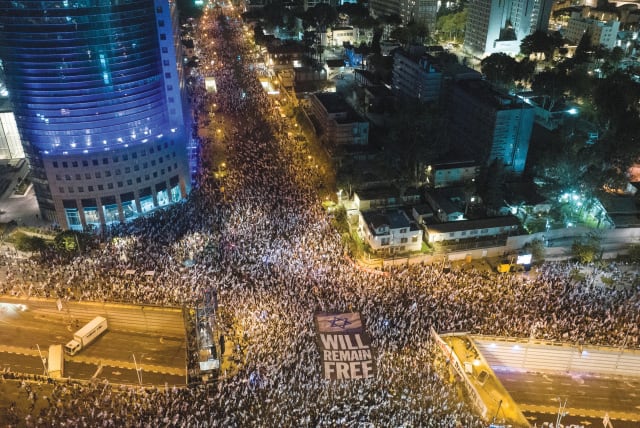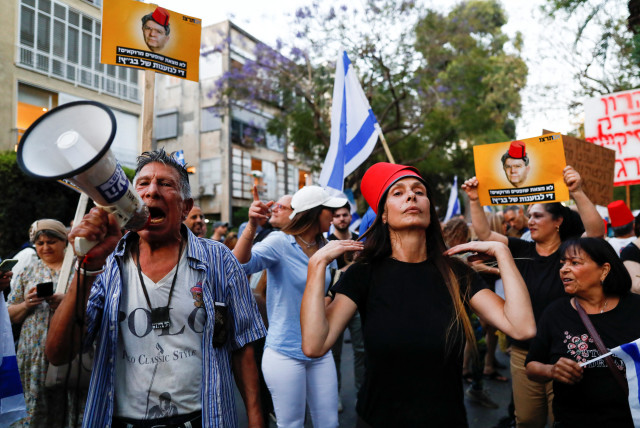Israeli national resilience: The 2023 resistance and how it could stop

As long as the threat to national resilience in Israel continues, this resistance response will continue as long as it is required.
For almost four months, the Israeli public has taken to the streets in protest. The phenomenon is an interesting subject for anyone analyzing national resilience, especially academics in the social sciences.
A generally accepted definition of social resilience (as distinct from economic or military resilience) at the national level is that resilience is the ability of a society/state to behave adaptively during a crisis or following a massive disruption in order to return to a previous or improved level of functioning.
Although there is no agreed-upon definition for the concept of national resilience, the definitions in the professional literature are quite similar. The main recurring elements of resilience are:
- Understanding it as the ability and willingness to adapt
- Manifesting itself in situations of crisis, disaster, or massive disruption of functional continuity
- Cognitive and behavioral components that can be expressed in resistance, containment, or adaptation.
The success of resilience is the return to a previous (or improved) level of functioning. In most cases, resilience is aimed at situations in which the crisis or the massive disruption are external to the society under analysis. Some are caused by nature (earthquakes, tsunamis, floods, etc.) and some by an external enemy (terrorism, war).
What is behind the disruption in Israeli national resilience?
IN THE current Israeli reality, the disruption comes from within – from the actions of the government, as well as from the huge protests (and their numerous variations – strikes, disobedience, etc.), which seem to be spreading in the public.
An important element in a nation’s or a society’s ability to cope with a crisis is the level of trust in the leadership. This occurs in two ways. A leader who receives a high degree of trust from the public directly causes the strengthening of the resilience of the society he heads. These expressions of resilience, when they come from all elements of society, strengthen the leader’s ability to make decisions. For instance, this occurred in several countries during the corona epidemic. The current reality in Israel demonstrates how critical and volatile this element of trust is.
Another factor in socio-national resilience is the ability to live together in a reasonable manner, despite disputes and conflicting interests. The threat to resilience stems from the fact that the ability to reconcile does not work and has been replaced, on the one hand, by an attempt to unilaterally impose sectoral interests; and, on the other hand, by an uprising and protest on the part of those who oppose these attempts at coercion.
Resilience researchers often use the metaphor of the bending tree. The behavior of resilience is like the ability of a flexible tree to bend during a storm and “bounce back” when the storm passes. This is in contrast to the rigid tree that is unwilling (or unable) to bend in the face of a strong wind and instead remains upright but risks breaking or totally collapsing.
The Israeli public that has been consistently participating in the nonviolent civil resistance – demonstrations, protests and disobedience throughout the country – does not indicate any “bending.” Instead, these “trees” remain upright throughout the ongoing storm.
This phenomenon raises troubling questions. Is there evidence of resilience here? Will this rigid stance, in fact, lead to a sudden break, like the stiff tree? Maybe resilience doesn’t have to be expressed precisely in “bending” that alternates with “bouncing back.”
Resilience, as mentioned, is the ability to behave adaptively. It can also include expressions of resistance and not just inclusion and acceptance. Another possible explanation is that there is, in fact, a “bending” in the face of the current storm: the departure of masses of people from their comfort zones to the streets to demonstrate and protest.
But there is another explanation, which corresponds to the metaphor of the tree bending in the storm. The current protest is precisely in the “bouncing back” phase. After a long period in which the majority of Israeli society contained the crisis and accepted the ills of the government, it “bowed down” in the face of governmental corruption and repeated elections and changes, which constituted the real disaster or disturbance.
After all, political functional continuity in Israel has already been extremely disrupted since the collapse of the 35th government in the summer of 2021. What better proof is there of the lack of functional continuity than four elections in two years, a prime minister who is accused of crimes, ministers and MKs who are in charge despite their proven criminal records, etc?
It’s possible that it took us too long to wake up or that we “fell asleep on guard” and didn’t recognize the disaster in time. But as soon as the danger was recognized, the healthy and “straightening” response immediately arrived (yes, the one referred to by certain ministers as “anarchism”).
This impressive “bouncing back,” expressed in the protest movement, sheds new light on the phenomenon of resilience. The current political situation, in an unprecedented way, threatens exactly the most important thing: Israeli national resilience. So far, the resilience has resulted from reasonable trust in the government, from a sense of common identity and agreed rules of the game, and from the fact that coercive processes, even when they existed, were relatively contained.
The raging legal “reform” threatens all of these, therefore threating the foundations of the resilience – economic, military-security and especially social – of the State of Israel. And when the threat is to the resilience and the fear is that our national resilience is at a critical risk, it is precisely then that we must demonstrate maximum resilience.
When will the resistance to the threat against Israeli national resilience end?
HOW WILL the situation evolve? In the view proposed here, as long as the threat to national resilience continues, this resistance response will continue as long as it is required. If the “trigger” for the breaking of this resistance was the appearance of danger, the trigger for the end of the resistance will be the ceasing of the danger.
History provides many examples of long-lasting resistance movements, from the Stalingrad standoff in World War II, to the 1960s civil rights movement in the US, to the civil uprising in Serbia that overthrew dictator Slobodan Milosevic.
From 1980 until today, according to research in the field of nonviolent civil uprisings, there were 55 successful nonviolent struggles against dictators, coercive regimes and “internal” oppression; another 10 were partially successful. Most of them demanded patience: 40 struggles lasted more than two years (for example, against Sudan’s dictator Jaafar Noumeiri; the struggle against one-party rule in Zambia; the expulsion of Madagascar dictator Didier Ratsiraka).
Five struggles took three years. These included the expulsion of Malawi dictator Hastings Banda; and the expulsion of dictator Ferdinand Marcos in the Philippines. Extreme resilience was shown by those fighting in Chile against dictator Augusto Pinochet in a struggle that lasted six years. Likewise, it took six years to liberate Slovakia from Czech control. And in South Africa, the struggle of the blacks who fought apartheid took decades.
Research indicates that this resilience derives, among other things, from the fact that nonviolent struggles are popular, and their leadership is decentralized. They share diverse audiences from different cultures and sectors, they mobilize the public through more extensive dialogue, and in their eyes, there is a democratic vision and an extensive vision of life after the dictatorship.
And so, here is our proposal for an updated definition of resilience – one that accurately describes the current situation in Israel: Socio-national resilience is the ability of a society to recognize (even if belatedly) a disturbance of internal or external origin or a massive disaster situation and react in the most optimal way to this disturbance (even if the response is total resistance). This response should not stop until there is a return to a desirable, functional state – perhaps even better than it was before. ■
Dr. Reuven Gal and Dr. Eitan Adres are senior research fellows at the Samuel Neaman Institute for National Policy Research. Nachi Alon is a clinical psychologist who studies the phenomenon of civil struggles.
Jerusalem Post Store
`; document.getElementById("linkPremium").innerHTML = cont; var divWithLink = document.getElementById("premium-link"); if (divWithLink !== null && divWithLink !== 'undefined') { divWithLink.style.border = "solid 1px #cb0f3e"; divWithLink.style.textAlign = "center"; divWithLink.style.marginBottom = "15px"; divWithLink.style.marginTop = "15px"; divWithLink.style.width = "100%"; divWithLink.style.backgroundColor = "#122952"; divWithLink.style.color = "#ffffff"; divWithLink.style.lineHeight = "1.5"; } } (function (v, i) { });

